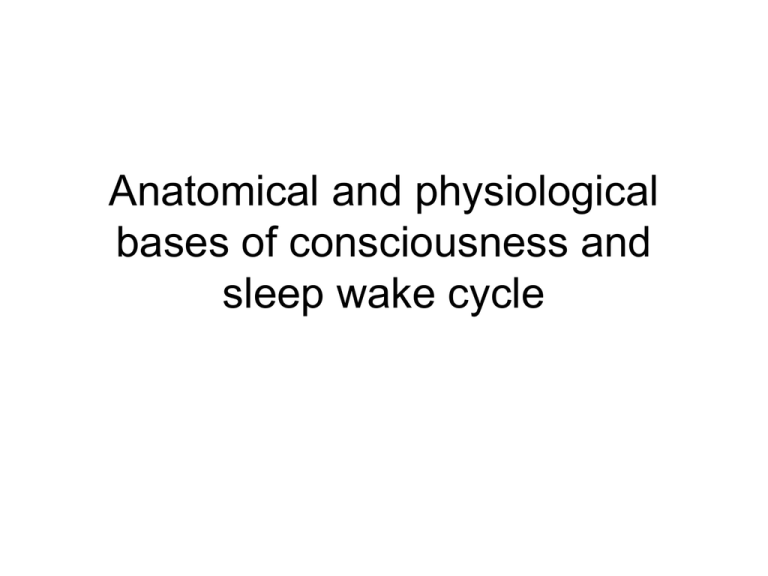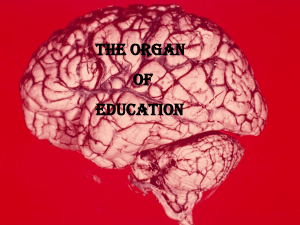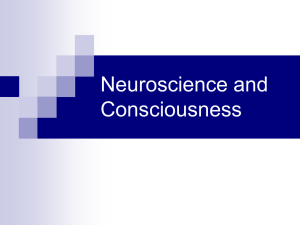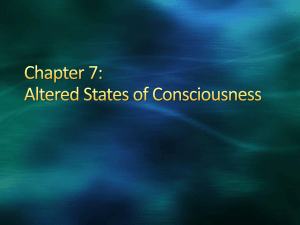Anatomical and physiological bases of consciousness and sleep
advertisement

Anatomical and physiological bases of consciousness and sleep wake cycle Consciousness • Definitions- consciousness is the ability to be aware of self and the surroundings. • It is the ability to know our own existence and of the existence of objects and events inside and outside our organism. • consciousness is a momentary creation of mental knowledge which describes a relation between the organism, on one hand, and an object or event, on the other. • consciousness is an integration of neural activity similar in mechanism to the binding of different aspects of sensation that occurs to produce a unified perception. Consciousness-- Anatomy of the consciousness system • Consciousness system– a diffuse & organized neuronal system in the brainstem, diencephalon & cerebral hemisphere • Structures in this system: 1. Portions of the brainstem reticular formation 2. Neurochemically defined nuclear groups of the brainstem 3. Thalamic nuclei 4. Basal forebrain 5. Ascending projections to the thalamus & cerebral cortex 6. widespread areas of the cerebral cortex Fig. Components of the consciousness system Reticular formation (RF) • RF- a complex aggregate of neurons whose cell bodies form neuronal clusters in the tegmental portion of the brainstem, i.e., from the level of the decussation of the pyramids in caudal medulla to the basal forebrain and thalamus. • The neurons are -characterized by long radiating dendrites that have few branches -axons have numerous collaterals & project for long distances -reticular= network forming== a single neuron receive many afferents & make synaptic contact with numerous neurons Reticular formation Subdivisions of RF • Functionally subdivided in to 1. midline region ( the raphe ) 2. medial region –containing large neurons that project to the spinal cord and to oculomotor nuclei 3. lateral region that receive axon colaterals from many ascending sensory pathways At the level of the medulla the lateral RF-participate in complex motor patterns such as respiration, swallowing, and vomiting Neurons in the ventrolateral medulla control respiration and circulatory system via projections to the spinal cord RF at pons & midbrain contain neuro-chemically defined groups of neurons that project to the cerebral cortex either directly or via thalamus Reticular formation Afferent pathways to the RF 1. 2. 3. 4. Collateral branches from the primary ascending tracts of sensory system (spinothalamic and spinoreticular pathways), which synapse with cells in the RF Fibers from the cerebral cortex, consisting of corticoreticular fibers from widespread cortical areas as well as collaterals from the corticospinal and corticobulbar tracts of the motor system. Fibers from other structures, including the cerebellum, basal ganglia, hypothalamus, cranial nerve nuclei, & the colliculi Visceral afferents from the spinal cord and cranial nerves Efferent pathways of RF • Efferent pathways project 1. rostrally to the forebrain 2. caudally to the spinal cord 3. to motor & internal regulation systems Output pathways of the brainstem reticular formation Neurochemical nuclear groups of the brainstem & basal forebrain • 1. cholinergic nuclear groups- in the basal forebrain & in the dorsal tegmentum of the upper pons and midbrain (=mesopontine tegmentum) –project to cerebral cortex & thalamus attention, wakefulness, REM sleep -Cholinergic structures of basal forebrain project to a. the cerebral cortex –regulation of behavioral functions, including cortical arousal, wakefulness, sensory processing, learning and memory b. Reticular nucleus of thalamus other thalamic nuclei– modulate activity of thalamus & thalamocortical projections -Cholinergic neurons of mesopontine tegmentum project to the thalamus & basal forebrain • 2. monoaminergic groups ( NE, 5-HT & histamine) Cont-• Regulate behavioral state & state-dependent cortical function • Located in the brainstem and hypothalamus • Send projections to the basal forebrain and cerebral cortex via the medial forebrain bundle A. Norepinephrine cells= located in locus ceruleus in the lateral part of the upper pons wakefulness & attention locus ceruleus= melanin pigmented bluish cells & rich in epinephrine =sends projections to areas mediating sensory stimulithalamus, hypothalamus, basal forebrain, cerebral cortex, cerebellum, and spinal cord B. Raphe nuclei=serotoninergic neurons wakefulness -located in the median area of brainstem -(upper pons & midbrain)=rostral group-project to thalamus, hypothalamus, basal forebrain, & cerebral hemispheres - caudal group=( lower pons & medulla) –project to spinal cord & brainstem cont C. Histamine neurons – arousal & wakefulness located in the posterior lateral hypothalamus Cont-- Basal forebrain area---projections ( for attention, motivation & memory) Thalamus • Gateway to the cerebral cortex • Two roles 1. relay station 2. filter & modulate flow of information to cortex Two main components: -A. relay nuclei contain 1. relay or projection neurons –containing glutamate –send excitatory input to the cortex 2. local inerneurons containing GABA- participate in thalamic local inhibitory circuit - B. reticular nucleus-containing GABAergic neurons projecting to other thalamic nuclei- inhibitory function & synchronize for rhythm in sleep _cortico-thalamo-cortical loop-coordinate processing of sensory information Thalamic nuclei of the consciousness system Thalamocortical projections of consciousness Cont-- Basal forebrain • A group of structures at ventral and medial aspects of cerebral hemispheres • Includes: • 1. nucleus basalis of Meynertcholinergic –projections to widespread areas of cortex Major source of extrathalamic input to cortex • 2. septal nucleus • The medial forebrain bundle – large tract - extends from midbrain tegmentum through lateral hypothalamus, into the septum, preoptic area, hypothalamus, basal olifactory region, & cingulate gyrus - represents the rostral extent of reticular system= ascending & descending connections Basal forebrain area---projections ( for attention, motivation & memory) Ascending pathways to the cerebral cortex • Two main types of projection pathways 1. thalamocortical pathways 2. Extrathalamic pathways- involving basal forebrain & medial forebrain bundle Ascending pathways of the consciousness system Thalamocortical pathways Extrathalamic pathways Input from Sensory relay nuclei spinal cord & brainstem Chilinergic & monoaminergic neuron groups in brainstem & basal forebrain Projection pathway Thalamic radiations Medial forebrain bundle Projects to Specific topographic areas Widespread areas of of cerebral cortex cerebral cortex & thalamus Function Relay & filter information to cerebral cortex Modulate activity of cerebral cortex & thalamus Activity Phasic / excitatory Tonic- conscious modulatory Dependent on Specific afferent stimulation Behavior state (wake-sleep) Thalamic & extra-thalamic pathways of consciousness system Cerebral cortex • All areas of cerebral cortex appear to participate in consciousness Physiology of the conscious system • Single cell- synaptic potential - action potential • Neuronal aggregate -EEG Functions of the consciousness system • Maintenance of consciousness, attention and regulation of wake-sleep cycle • Consciousness–awareness of environment and self = two aspects: 1. content of consciousness- representing cognitive mental functions that reflect the activity of the cerebral cortex 2. arousal and wakefulness –dependent on the reticular activating system and its projections which in turn are activated by sensory stimuli or cortical influences Cont-- • Neurons of the RF & basal forebrain diffusely activate cortex directly & via thalamus. • They receive inputs from restricted areas of the cortex – orbitofrontal & superior temporal cortex and stimulation of these areas evokes an arousal response • Cholinergic & monoaminergic inputs have a dual effect on the thalamocortical circuits: • 1. at the level of the thalamus, they inhibit burst activity and facilitate sensory stimulation • 2. at the cortex- they increase excitability and responsiveness of cortical neurons to thalamic & cortical inputs Cont-• Cholinergic neurons of basal forebrain & locus ceruleus increase their activity in response to new and challenging stimuli and are involved in arousal, attention & motivation • Histaminergic neurons in the posterior lateral hypothalamus are also involved in cortical arousal and motivated behavior • Decreased activity of both cholinergic and monoaminergic inputs results in progressive decrease in excitability of thalamocortical circuits Attention • Thalamus enhance or attenuate responses to incoming stimuli and direct attention to specific input while suppressing other incoming stimuli • Consciousness system influences degree of overall attentiveness to the environment and perception of specific sensory modalities Functional states of cerebral cortex and thalamocortical circuits Thalamocorical activation Thalamocorical inactivation Ascending input from Present mesopontine RF Reduced Thalamic activity Tonic-single spikes Rhythmic burst firing Sensory processing Present impaired EEG Low-voltage fast activity High-voltage, rhythmic slow activity Examples Wakefulness REM sleep Non-REM sleep General anesthesia Absence seizure Coma Sleep -• • • • • B. Sleep: Nature & Stages Older notions: Some thought sleep was the brain's response to lowered levels of stimulation from the senses. Others argued that sleep was a necessary stage for the organism to repair or to rest itself so that it wouldn't break down. Both these notions are incorrect. Defining Sleep: a cyclic, temporary and physiologic loss of consciousness that is readily, promptly and completely reversed by appropriate stimuli "Sleep is an actively induced, highly organized brain state" marked by these four qualities -– 1. Reduced motor activity – 2. Lowered response to sensory stimulation – 3. Adoption of stereotypic postures such as lying down with the eyes closed, and – 4. Easy reversibility (compared to coma, stupor, hibernation, etc.) Cont--- Cont-- • • • • • • Non-REM Sleep includes Stages 1 to 4 Stage 1: Mostly theta waves Stage 2: Sleep spindles and K-complex waves Stage 3: Mostly delta waves Stage 4: Delta waves; hard to awaken May involve dreaming • REM (Rapid Eye Movement) Sleep (= "paradoxical" sleep) • Brain waves somewhat similar to awake state or Stage 1 sleep (lowvoltage, mixed/fast waves) • Rapid eye movements • Almost complete loss of muscle control ("atonia") • Penile erections (males) & vaginal moistening (females) • Easy to awaken • Usually a time of more intensive, vivid dreams Characteristics of REM &non-REM sleep Sleep activity Eye movement Body movement Non-REM sleep Slow (drowsiness) Muscle relaxation Vital signs Muscle tone REM sleep Rapid Muscle twitches Fluctuating decreased Penile erection common Rare Dreams EEG Common Low voltage Rare Spindles, V-waves, Kcomplexes, slow waves Stable Some tone in postural muscle Percentage-adults 20-25 75-80 Percentage-infants 50 50 Cont-- • Sleep Cycle • Movement from Stage 1 to Stage 4 and back to Stage 1 • REM Sleep substitutes for Stage 1 sleep during cycle • Between 90-110 minutes to move through an entire cycle • Each night = 3 to 5 complete cycles Sleep-- • Sleep is an active phenomenon in which hypnogenic areas of the brain and neurochemical substances actively promote sleep and inhibit arousal system. • Structures for sleep regulation are • 1. raphe nuclei ( 5-HT)- in the upper medullary & lower pontine • 2. locus ceruleus (NE)- in the lateral portion of upper pons and lower midbrain • 3. the nucleus of tractus solitarius in the medulla • 4. dorsolateral pons (Ach) • 5. the anterior portion of the hypothalamus • 6. the reticular nucleus of thalamus • 7. the basal forebrain preoptic area Biological Mechanisms of Sleep & Wakefulness Arousal • pontomesencephalon (reticular formation) • connected to thalamus & basal forebrain • arousal of cortex & increased alertness to new tasks • Acetylcholine (ACh) & glutamate = excitatory • dorsal raphe nucleus • inhibits basal forebrain GABA cells (therefore, prevents inhibition in cortex) • Serotonin • locus coeruleus (dorsal pons) • connected to many areas of the cortex • influential in the storage of recent memories • Norepinephrine Arousal-- • basal forebrain (anterior to hypothalamus) • connected to thalamus and cortex • overall arousal, attention to stimuli, increased learning • subject to damage in Alzheimer's disease (impaired attention & memory) • Acetylcholine (ACh) = excitatory GABA = inhibitiory • hypothalamus • arousal • antihistamine drugs may cause drowsiness • Histamine sleep • Sleep • lower temperature • lowered brain temperature is associated with sleep; thus, • cooling body leads to sleep • inhibition of arousal • Adenosine • adenosine (an end-product of metabolic processes) builds up in brain during activity • in the basal forebrain, adenosine receptors inhibit some arousal neurons and this sustains sleep Sleep-- • accumulated adenosine due to lack of sleep will cause sleepiness over later days ("sleep deficit or debt") • Caffeine blocks adenosine receptors • prostaglandins • (found in most body cells; involved in inflammation, pain, & fever in response to infection; role in labor; inhibited by aspirin) build up during day & stimulate inhibitory neurons in the hypothalamus • GABA • Increased hypothalamic GABA release helps lead to sleep Brain Function in REM Sleep • Activity in the pons triggers REM sleep which is associated with a distinctive pattern: PGO waves (see figure ) • The pons also sends instructions to spinal cord to inhibit motor neurons associated with large muscles Cont--- Comparison of wakefulness and sleep State wakefulness Non-REM sleep REM sleep Cholinergic input Active Reduced Active Monoaminergic Active input Reduced absent Sensory processing Present for outside information Absent Present for stored information (dreaming) Attention Present Absent Absent EEG Alpha –eyes closed Spindles, K Low amplitude-eyes complex, highvoltage, delta open rhythm Low-voltage, fast activity Sleep Abnormalities • Insomnia= not sleeping enough due to (1) difficulty falling asleep (onset insomnia) (2) frequent awakening during sleep (maintenance insomnia), or (3) waking up too early (termination insomnia) • Sleep Apnea= intermittent stopping of breathing during sleep • Narcolepsy= frequent, unexpected periods of sleep or sleepiness during the day. • Includes one or more of these symptoms: 1. Gradual/sudden onset of sleepiness 2. Cataplexy: muscle weakness while remaining awake. Often triggered by strong emotions 3. Sleep paralysis: inability to move when falling asleep or waking up Sleep Abnormalities • 4. Hypnagogic hallucinations: dreamlike experiences at the beginning of sleep. • Equivalent to REM-like sleep intruding into the awake state Cause is unknown. • Possibly due to Overactive ACh synapses in the pons which send messages to spinal cord; or, • Axons using the neurotransmitter orexin (hypocretin) in the hypothalamus connect to areas which increase arousal & wakefulness. • Humans with narcolepsy do not have these cells in the hypothalamus (perhaps due to an autoimmune disorder). Cont-- • Periodic Limb Movement D/O = during NREM sleep individual moves legs and sometimes arms every 20-30 seconds for minutes or hours • REM Behavior D/O= during REM sleep individual moves vigorously or violently (kick, punch, etc.); dreams of violent nature; occurs mostly in older men with brain diseases, esp. PD. • Night Terrors = an experience intense anxiety from which one wakes up screaming in terror • Sleep Talking We all do it. • Sleepwalking • usually children 2-5 years old • harmless; no danger to wake the sleepwalking person up





